warning light TOYOTA TUNDRA 2011 2.G Owners Manual
[x] Cancel search | Manufacturer: TOYOTA, Model Year: 2011, Model line: TUNDRA, Model: TOYOTA TUNDRA 2011 2.GPages: 732, PDF Size: 16.65 MB
Page 2 of 732

TABLE OF CONTENTSIndex
2
1-1. Key informationKeys ..................................... 42
1-2. Opening, closing and locking
the doors
Wireless remote control ....... 44
Side doors ............................ 47
Tailgate ................................ 52
1-3. Adjustable components
(seats, mirrors, steering
wheel)
Front seats ........................... 58
Rear seats (Double Cab and CrewMax models) ....... 63
Driving position memory (driver’s seat) ..................... 68
Head restraints ..................... 71
Seat belts ............................. 75
Steering wheel (manually adjustable type) .................. 83
Steering wheel (power-adjustable type)...... 85
Anti-glare inside rear view mirror .................................. 86
Outside rear view mirrors ..... 89
1-4. Opening and clos ing
the win dows and moon roof
Power windows .................... 94
Back window ........................ 98
Power back window ............. 99
Moon roof ........................... 102 1-5. Refueling
Opening the fuel tank cap... 107
1-6. Theft deterrent system Engine immobilizer system .............................. 112
Alarm .................................. 114
1-7. Safety information Correct driving posture ....... 117
SRS airbags ....................... 119
Front passenger occupant classification system ......... 135
Child restraint systems ....... 142
Installing child restraints ..... 148
2-1. Driving procedures Driving the vehicle .............. 172
Engine (ignition) switch....... 181
Automatic transmission ...... 184
Turn signal lever ................. 189
Parking brake ..................... 190
Horn .................................... 191
2-2. Instrument cluster Gauges and meters ............ 192
Indicators and warning lights ................................. 198
Multi-information display ..... 203
Accessory meter ................. 209
1Before driving
2When driving
Page 5 of 732

1
2
3
4
5
6
7
5
Compass ............................. 510
4-1. Maintenance and care Cleaning and protecting the vehicle exterior............ 516
Cleaning and protecting the vehicle interior............. 519
4-2. Maintenance Maintenance requirements ..................... 522
General maintenance.......... 524
Emission inspection and maintenance (I/M)
programs........................... 527
4-3. Do-it-yourself maintenance Do-it-yourself service precautions ....................... 528
Hood ................................... 532
Engine compartment ........... 533
Tires .................................... 547
Tire inflation pressure ......... 554
Wheels ................................ 558
Air conditioning filter............ 560
Wireless remote control battery ............................... 563
Checking and replacing fuses ................................. 565
Light bulbs........................... 576 5-1. Essential information
Emergency flashers............ 588
If your vehicle needs to be towed........................... 589
If you think something is wrong ............................... 595
Fuel pump shut off system .............................. 596
Event data recorder ............ 597
5-2. Steps to take in an emergency If a warning light turns on or a warning buzzer
sounds... .......................... 599
If a warning message is displayed (vehicles with
multi-information
display) ............................. 608
If you have a flat tire ........... 612
If the engine will not start.... 628
If the shift lever cannot be shifted from P ................... 630
If you lose your keys........... 633
If the vehicle battery is discharged........................ 634
If your vehicle overheats .... 637
If the vehicle becomes stuck ................................. 640
If your vehicle has to be stopped in
an emergency .................. 641
4Maintenance and care
5When trouble arises
Page 28 of 732
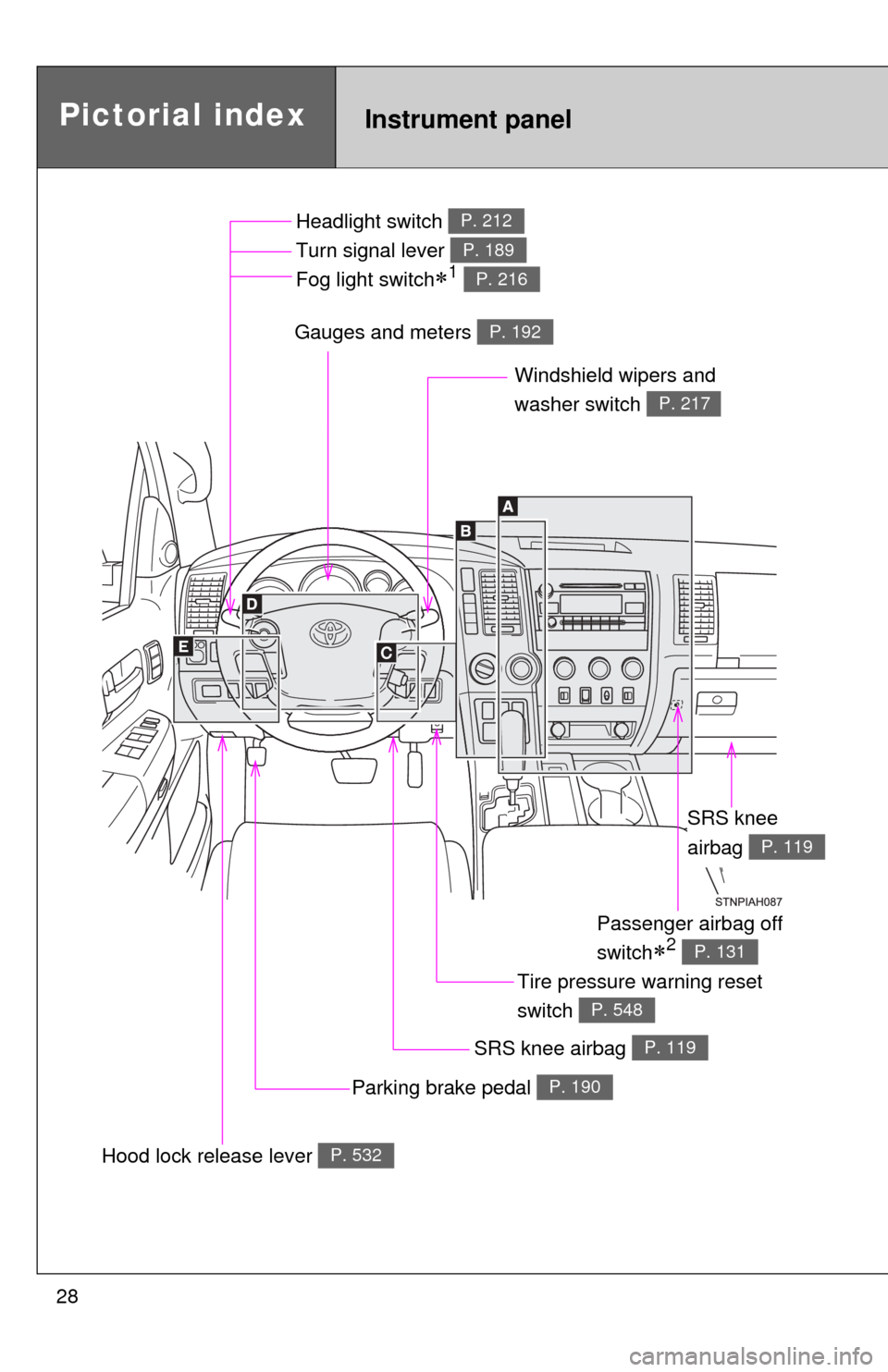
28
Pictorial indexInstrument panel
Headlight switch
Turn signal lever
Fog light switch
1
P. 212
P. 189
P. 216
Windshield wipers and
washer switch
P. 217
Parking brake pedal P. 190
Gauges and meters P. 192
Hood lock release lever P. 532
Tire pressure warning reset
switch
P. 548
Passenger airbag off
switch
2 P. 131
SRS knee
airbag
P. 119
SRS knee airbag P. 119
Page 81 of 732
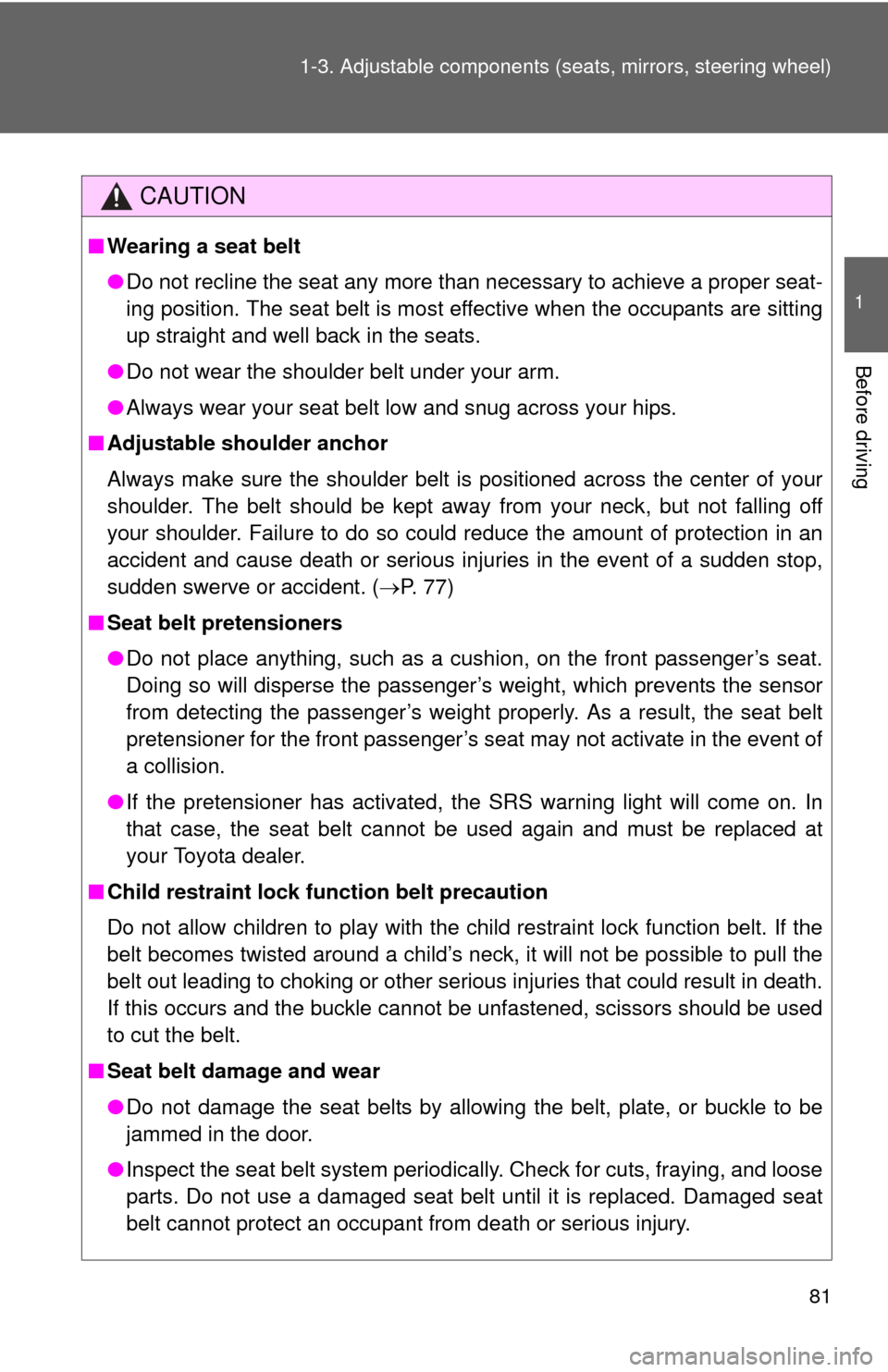
81
1-3. Adjustable components (s
eats, mirrors, steering wheel)
1
Before driving
CAUTION
■Wearing a seat belt
●Do not recline the seat any more than necessary to achieve a proper seat-
ing position. The seat belt is most effective when the occupants are sitting
up straight and well back in the seats.
● Do not wear the shoulder belt under your arm.
● Always wear your seat belt low and snug across your hips.
■ Adjustable shoulder anchor
Always make sure the shoulder belt is positioned across the center of your
shoulder. The belt should be kept away from your neck, but not falling off
your shoulder. Failure to do so could reduce the amount of protection in an
accident and cause death or serious injuries in the event of a sudden stop,
sudden swerve or accident. ( P. 77)
■ Seat belt pretensioners
●Do not place anything, such as a cushion, on the front passenger’s seat.
Doing so will disperse the passenger’s weight, which prevents the sensor
from detecting the passenger’s weight properly. As a result, the seat belt
pretensioner for the front passenger’s seat may not activate in the event of
a collision.
● If the pretensioner has activated, the SRS warning light will come on. In
that case, the seat belt cannot be used again and must be replaced at
your Toyota dealer.
■ Child restraint lock function belt precaution
Do not allow children to play with the child restraint lock function belt. If the
belt becomes twisted around a child’s neck, it will not be possible to pull the
belt out leading to choking or other serious injuries that could result in death.
If this occurs and the buckle cannot be unfastened, scissors should be used
to cut the belt.
■ Seat belt damage and wear
●Do not damage the seat belts by allowing the belt, plate, or buckle to be
jammed in the door.
● Inspect the seat belt system periodically. Check for cuts, fraying, and loose
parts. Do not use a damaged seat belt until it is replaced. Damaged seat
belt cannot protect an occupant from death or serious injury.
Page 121 of 732
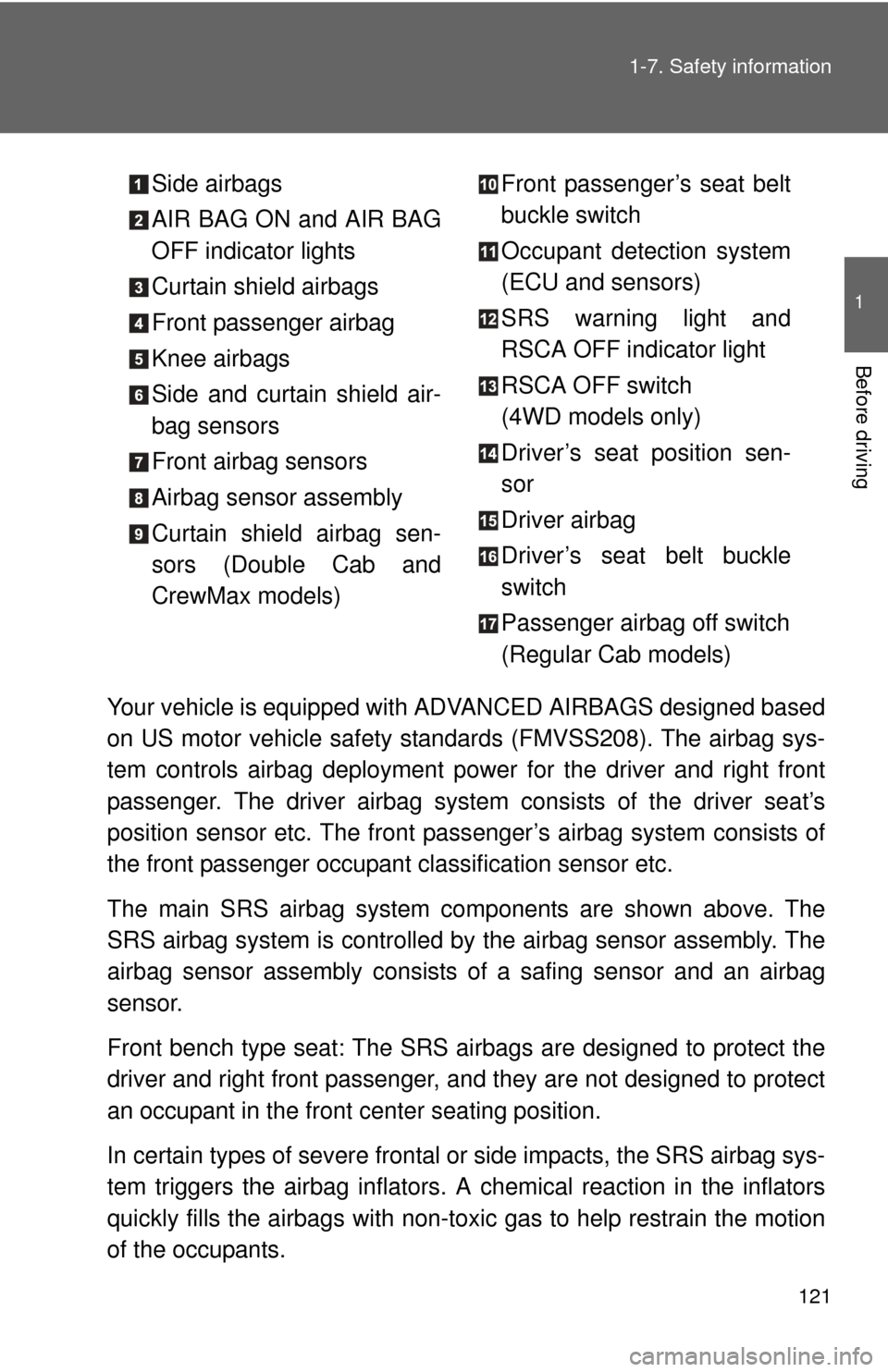
121
1-7. Safety information
1
Before driving
Your vehicle is equipped with
ADVANCED AIRBAGS designed based
on US motor vehicle safety standards (FMVSS208). The airbag sys-
tem controls airbag deployment power for the driver and right front
passenger. The driver airbag system consists of the driver seat’s
position sensor etc. The front pass enger’s airbag system consists of
the front passenger occupant classification sensor etc.
The main SRS airbag system components are shown above. The
SRS airbag system is controlled by the airbag sensor assembly. The
airbag sensor assembly consists of a safing sensor and an airbag
sensor.
Front bench type seat: The SRS airbags are designed to protect the
driver and right front passenger, and they are not designed to protect
an occupant in the front center seating position.
In certain types of severe frontal or side impacts, the SRS airbag sys-
tem triggers the airbag inflators. A chemical reaction in the inflators
quickly fills the airbags with non-toxic gas to help rest rain the motion
of the occupants. Side airbags
AIR BAG ON and AIR BAG
OFF indicator lights
Curtain shield airbags
Front passenger airbag
Knee airbags
Side and curtain shield air-
bag sensors
Front airbag sensors
Airbag sensor assembly
Curtain shield airbag sen-
sors (Double Cab and
CrewMax models)
Front passenger’s seat belt
buckle switch
Occupant detection system
(ECU and sensors)
SRS warning light and
RSCA OFF indicator light
RSCA OFF switch
(4WD models only)
Driver’s seat position sen-
sor
Driver airbag
Driver’s seat belt buckle
switch
Passenger airbag off switch
(Regular Cab models)
Page 122 of 732

122 1-7. Safety information
■SRS warning light
This warning light system monitors the airbag sensor assembly, front airbag
sensors, side and curtain shield airbag sensor assemblies, curtain shield air-
bag sensor assemblies, driver’s seat position sensor, driver’s seat belt
buckle switch, front passenger occupant classification system, AIR BAG ON
and AIR BAG OFF indicator lights, front passenger’s seat belt buckle switch,
passenger airbag off switch (Regular C ab models), front seat belt preten-
sioner assemblies, RSCA OFF indicator light, inflators, interconnecting wir-
ing and power sources. ( P. 600)
■ If the SRS airbags deploy (inflate)
●Bruising and slight abrasions may result from contact with a deploying
(inflating) SRS airbag.
● A loud noise and white powder will be emitted.
● Parts of the airbag module (steering wheel hub, airbag cover and inflator)
as well as the front seats, and parts of the front and rear pillars and roof
side rail, may be hot for several minutes. The airbag itself may also be
hot.
● The front windshield may crack.
■ Operating conditions (front airbags)
● The SRS front airbag will deploy in the event of an impact that exceeds
the set threshold level (the level of force corresponding to an approxi-
mately 12-18 mph [20-30 km/h] frontal collision with a fixed wall that does
not move or deform).
However, this threshold velocity will be considerably higher if the vehicle
strikes an object, such as a parked vehicle or sign pole, which can move or
deform on impact, or if the vehicle is involved in an underride collision (e.g.
a collision in which the front of the vehicle “underrides”, or goes under, the
bed of a truck, etc.).
● It is possible that in some collisions where the forward deceleration of the
vehicle is very close to the designed threshold level, the SRS front air-
bags and the seat belt pretensioners may not activate together.
● The SRS front passenger airbag will not activate if there is no passenger
sitting in the right front passenger seat. However, the front passenger air-
bag may deploy if luggage is put in the seat, or the seat belt is fastened,
even if the seat is unoccupied. ( P. 135)
Page 135 of 732
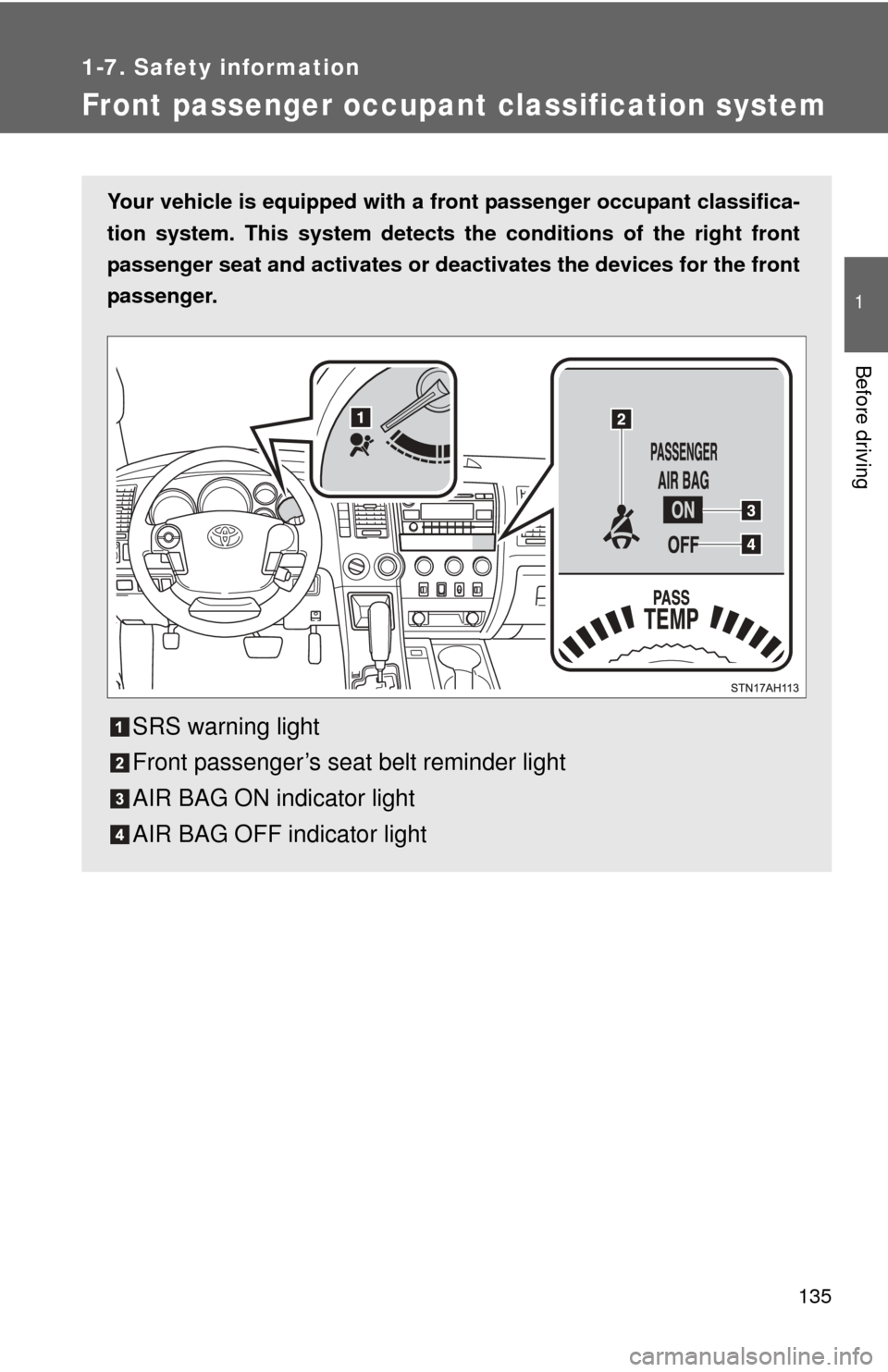
135
1
1-7. Safety information
Before driving
Front passenger occupant classification system
Your vehicle is equipped with a front passenger occupant classifica-
tion system. This system detects the conditions of the right front
passenger seat and activates or deactivates the devices for the front
passenger.
SRS warning light
Front passenger’s seat belt reminder light
AIR BAG ON indicator light
AIR BAG OFF indicator light
Page 136 of 732
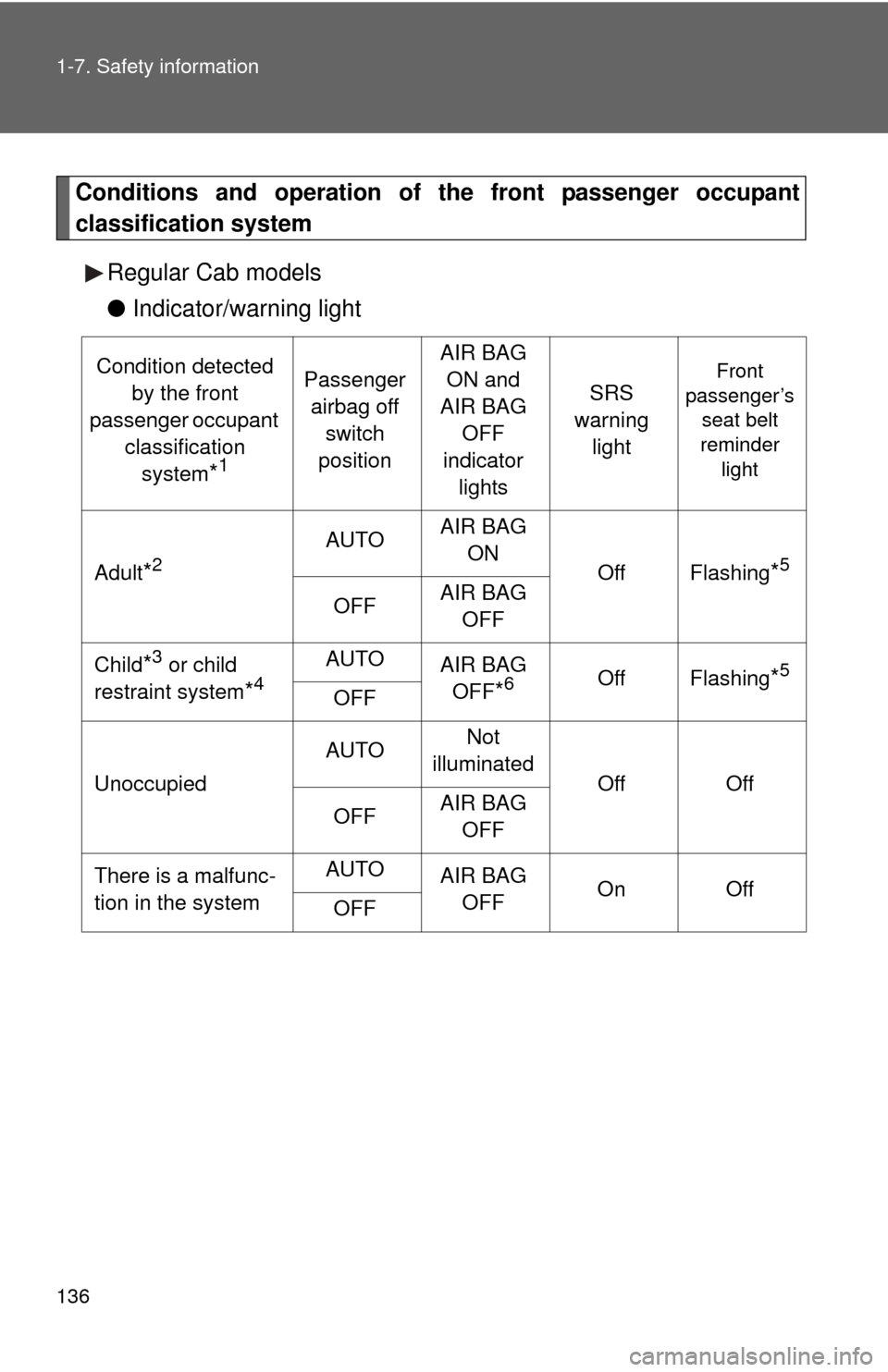
136 1-7. Safety information
Conditions and operation of the front passenger occupant
classification system
Regular Cab models
●Indicator/warning light
Condition detected
by the front
passenger occupant classification system
*1
Passenger airbag off switch
position
AIR BAG ON and
AIR BAG OFF
indicator lights
SRS
warning light
Front
passenger’s seat belt
reminder light
Adult*2
AUTOAIR BAG
ON
OffFlashing*5
OFFAIR BAG OFF
Child*3 or child
restraint system
*4
AUTOAIR BAG OFF
*6OffFlashing*5
OFF
Unoccupied
AUTONot
illuminated
OffOff
OFFAIR BAG OFF
There is a malfunc-
tion in the systemAUTOAIR BAG OFFOnOffOFF
Page 138 of 732
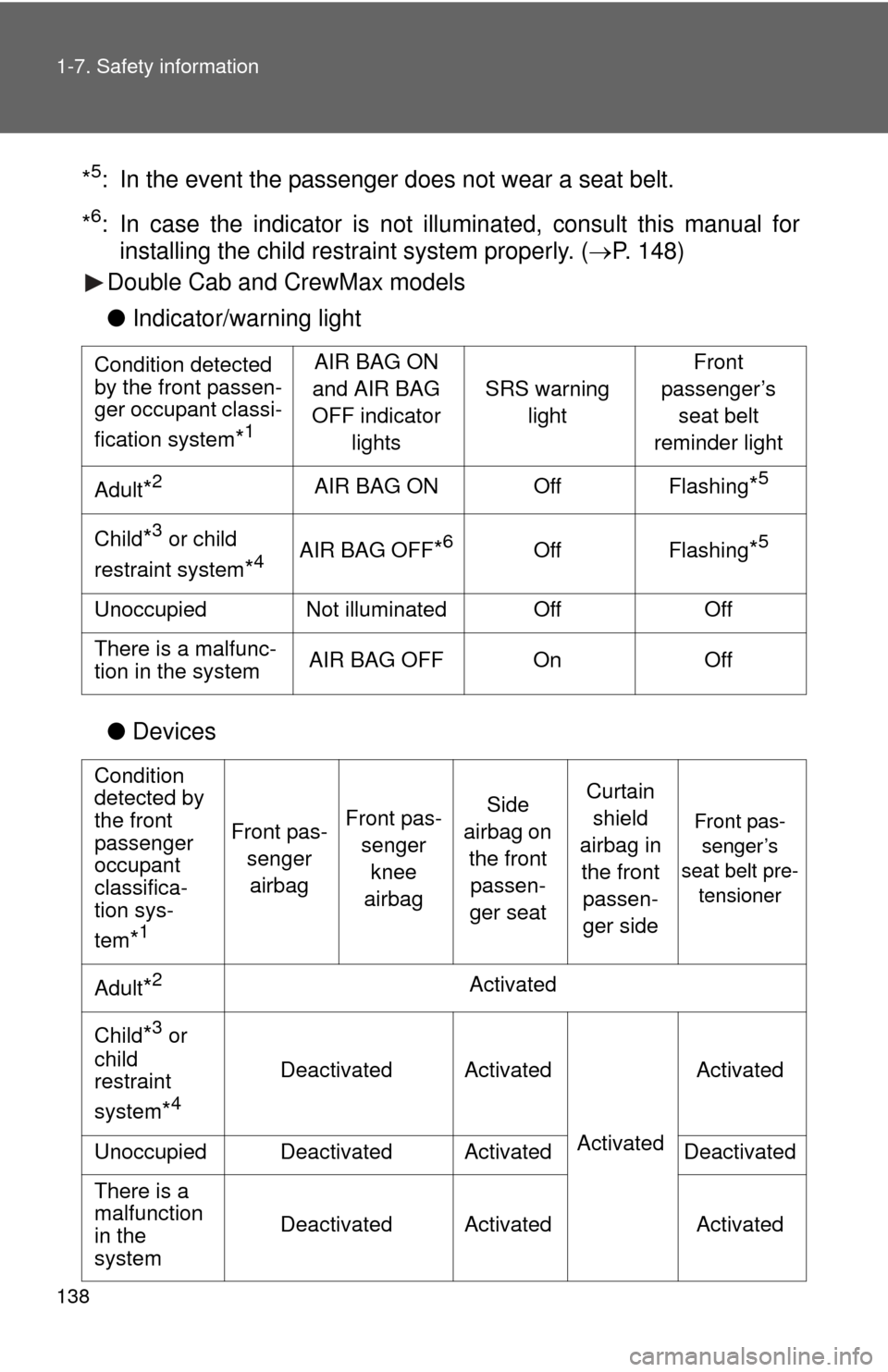
138 1-7. Safety information
*5: In the event the passenger does not wear a seat belt.
*
6: In case the indicator is not illu minated, consult this manual for
installing the child restraint system properly. ( P. 148)
Double Cab and CrewMax models
● Indicator/warning light
● Devices
Condition detected
by the front passen-
ger occupant classi-
fication system
*1
AIR BAG ON
and AIR BAG
OFF indicator lights
SRS warning light
Front
passenger’s seat belt
reminder light
Adult*2AIR BAG ONOffFlashing*5
Child*3 or child
restraint system
*4AIR BAG OFF*6OffFlashing*5
UnoccupiedNot illuminatedOffOff
There is a malfunc-
tion in the systemAIR BAG OFFOnOff
Condition
detected by
the front
passenger
occupant
classifica-
tion sys-
tem
*1
Front pas- senger airbagFront pas- senger knee
airbagSide
airbag on the front passen-
ger seatCurtain shield
airbag in the front passen-
ger side
Front pas- senger’s
seat belt pre- tensioner
Adult*2Activated
Child*3 or
child
restraint
system
*4
DeactivatedActivated
Activated
Activated
UnoccupiedDeactivatedActivatedDeactivated
There is a
malfunction
in the
system
DeactivatedActivatedActivated
Page 140 of 732

140 1-7. Safety information
CAUTION
■Front passenger occupant cl assification system precautions
● Do not apply a heavy load to the front passenger seat or equipment (e.g.
seatback pocket).
● Do not apply pressure to the right front passenger seat by resting hands or
legs on the seatback.
● Double Cab and CrewMax models: Do not put weight on the front passen-
ger seat by putting your hands or feet on the front passenger seat seat-
back from the rear passenger seat.
● Double Cab and CrewMax models: Do not let a rear passenger lift the
front passenger seat with their feet or press on the seatback with their
legs.
● Do not put objects under the front passenger seat.
● Do not recline the front passenger seatback so far that it touches a rear
seat or a back wall. This may cause the AIR BAG OFF indicator light to be
illuminated, which indicates that the passenger’s airbags will not deploy in
the event of a severe accident. If the seatback touches the rear seat or
back wall, return the seatback to a position where it does not touch the
rear seat or back wall. Keep the front passenger seatback as upright as
possible when the vehicle is moving. Reclining the seatback excessively
may lessen the effectiveness of the seat belt system.
● If an adult sits in the right front passenger seat, the AIR BAG ON indicator
light is illuminated. If the AIR BAG OFF indicator is illuminated, ask the
passenger to sit up straight, well back in the seat, feet on the floor, and
with the seat belt worn correctly. If the AIR BAG OFF indicator still remains
illuminated, either ask the passenger to move to the rear seat, or if that is
not possible, move the right front passenger seat fully rearward.
● When it is unavoidable to install the forward-facing child restraint system
on the front passenger seat, install the child restraint system on the front
passenger seat in the proper order. (P. 148)
● Do not modify or remove the front seats.
● Do not kick the front passenger seat or subject it to severe impact. Other-
wise, the SRS warning light may come on to indicate a malfunction of the
detection system. In this case, contact your Toyota dealer immediately.